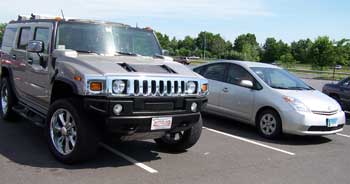Each of us has an “ecological footprint” – an estimate of how much productive land and water are needed to support our lifestyle. Many people are astonished to learn that the average ecological footprint in the U.S. is 24 acres per person. Unfortunately, worldwide, there are only 4.5 biologically productive acres per person. That means that if everyone lived the way we do, we would need five planets worth of resources.
The choices we make on a daily basis can affect our ecological footprint. One choice involves automobiles: what kind we drive, how often and how far we drive it, how we drive it, and how many people ride in it.
Air Pollution: Driving is probably the single most polluting thing you do as an individual. An average passenger vehicle driven 12,500 miles a year emits 121,403 pounds of hydrocarbons, carbon monoxide and dioxide, and oxides of nitrogen. These pollutants contribute to global climate change and public health impacts like respiratory illnesses.
 |
| According to the U.S. Environmental Protection Agency, a hybrid Toyota Prius is the most fuel efficient car, averaging 48 mpg in the city, and 45 on the highway. Compare that to 9 and 12 mpg for a Hummer H2. |
Energy Use: Oil is a non-renewable resource, since fossil fuels are not being made anymore. To feed our love affair with cars, the U.S. imports more than ten million barrels of oil per day. The average car in the U.S. gets about 20 miles per gallon (mpg). According to the U.S. Environmental Protection Agency, a hybrid Toyota Prius is the most fuel efficient car, averaging 48 mpg in the city, and 45 on the highway. Compare that to 9 and 12 mpg for a Hummer H2.
Road Kill: Flattened fauna are a common sight in the Quiet Corner, from the dragonfly that bounces off a windshield to the moose hit by a car in New Canaan on June 5th (one of only 100 Statewide.) Roadside lights attract bugs, which in turn attract locomotively-challenged animals like frogs and toads that are not good at evading traffic. Many animals must cross a road to feed, find a mate or reach habitat suitable for reproduction. For example, Eastern Box Turtles are a Species of Special Concern in Connecticut. They do not reach sexual maturity until they are 14-16 years old, and then only lay 1-9 eggs in a clutch. Since the mortality rate for hatchlings is high, their strategy for survival is to live a long time – up to 149 years. But that life could end in a millisecond under the tires of a car.
Chemical Use: Automobiles need to be maintained. We use water and detergent to clean them. We also use and dispose of things like antifreeze, tires, brake linings and other car parts. Every year, an estimated 180-350 million gallons of used oil is discarded into storm drains, water ways and onto the ground. That is 10-30 times more than the 10.8 million gallons of oil spilled by the Exxon Valdez.
Litter: Last month, DOT trucks picked up more than 30 bags of litter along a two-mile stretch of highway in Woodstock, CT. Most of it was either blown out of or thrown out of a vehicle.
Life Cycle Impacts: The U.S. Department of Transportation estimates that the average life span of an automobile is just over 13 years, or 145,000 miles. Scrap cars have to be managed somehow. Roads, a key part of the infrastructure that supports travel, are sanded or salted in the winter. There are also significant environmental impacts associated with fuel storage and transportation.
What you can do to reduce your own Environmental Tire Tread:
- Instead of driving, see if you can (or you can convince your offspring to) replace one car trip a week with walking, biking, public transportation, ridesharing, or combining it with another trip. If you used means of transportation for just one 20 mile trip each week, it would reduce your weekly carbon dioxide emission by 18 lbs.
- Talk to your employer about telecommuting some of the time, or working four days every week or every other week.
- Recycle used oil.
- Keep your tires properly inflated to reduce fuel consumption.
- When it is time for another car, consider a fuel efficient model with lower tailpipe emissions.
- Drive the speed limit to economize on fuel and enable you to safely avoid wildlife.
|

